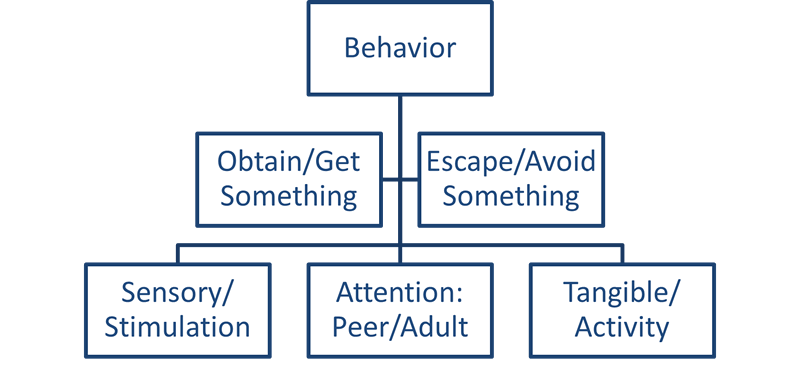Functional Factors
Big Picture
"All Behavior Serves a Function"
All behavior happens for a reason, it is not simply random. It serves a purpose (function) for the student who uses it. This behavior has worked in the past for the student or is working currently to achieve an outcome desired by the student. We commonly refer to these common functions of behavior with the acronym of S.E.A.T.
Sensory: Sensory input or experiences to the individual that feel good or relieving to the student. (i.e., "looks good", "taste good", "feels good", "smells good", "sounds good").
Escape(avoid): certain people, demands, settings, noises, aversive stimuli.
Attention: From peer(s), adults. Attention can be positive attention or negative attention.
Tangible: Access to an item or activity (i.e., food, toys, electronics, and other tangible items)
We often refer to these functions in terms of "getting something" or "rejecting something" within the students' environment. Please see visual below:

Rationale
A careful analysis in determining the function of challenging behavior is critical if we are to identify an adequate Functionally Equivalent Replacement Behavior (FERB) and environmental intervention(s) to eliminate or reduce the student's use of the challenging behavior. A misidentified function may result in little to no change in behavior or exacerbate/increase students' use of challenging behavior.
Key Concepts
- The function must logically relate to known or identified antecedents and consequences (i.e. How do the identified antecedents connect to the function?)
- The function must be behaviorally based and not a description of the student's disability category (i.e. "student engages in behavior due to their ADHD")
- The function must never be described in terms other than the common functional terms of behavior (i.e., to get or avoid something in terms of sensory, attention, escape, or tangible).
- Some behaviors may have more than one function.
Assessment
Function is determined by looking at the events before and after the behavior is performed over time (not in a single observation). Therefore, accurate ongoing A-B-C data is important because it tells us "why" the behavior occurs (the function). A-B-C data collected over multiple episodes can reveal common antecedents and consequences across the episodes.
Examples/Non-Examples:
Example of Escape Function:
Behavior |
Known/Identified Antecedents |
Reported Consequences |
Hypothesized Function |
Explanation |
|---|---|---|---|---|
Student hits adults with a closed fist |
Student is given lengthy and difficult worksheets |
Worksheets are removed and student is sent to the office |
Escape Student hits to escape work that is too challenging to do, or that they perceive as challenging or lengthy. |
This example is logically related to antecedents identified in antecedent information |
Non-Example of Attention Function:
Behavior |
Known/Identified Antecedents |
Reported Consequences |
Hypothesized Function |
Explanation |
|---|---|---|---|---|
Student hits adults with a closed fist |
Student is given lengthy and difficult worksheets |
Worksheets are removed and student is sent to the office |
Non-Example: Attention Student hits because they like peer attention. |
The hypothesized function does not logically relate to known/identified antecedents and reported consequences following behavior. |
Non-Example "Revenge" as function:
Behavior |
Known/Identified Antecedents |
Reported Consequences |
Hypothesized Function |
Explanation |
|---|---|---|---|---|
Student hits adults with a closed fist |
Student is given lengthy and difficult worksheets |
Worksheets are removed and student is sent to the office |
Non-Example: Revenge "Student hits in order to seek revenge against others" |
The hypothesized function does not describe function in terms of sensory, escape, attention, or tangible. Using non-behavioral terms such as "revenge", "vengeance", "power", or "control" are not rooted in behavior analysis and thus will contaminate the efficacy of the intervention plan. |
Back to Environmental Factors | Next to Replacement Behavior


